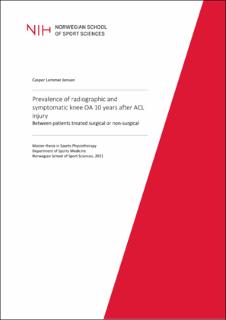| dc.description.abstract | Background: Following an Anterior Cruciate Ligament (ACL) injury, there is an 3-4 times increased chance of developing post-traumatic osteoarthritis (PTOA). After an ACL injury, the treatment options are typically an ACL Reconstruction (ACLR) with rehabilitation or rehabilitation-alone. Earlier studies have shown no difference between these two groups regarding pain, symptoms, or radiographic Osteoarthritis (OA). But more high-quality research surrounding the prevalence of symptomatic and radiographic OA is warranted.
Objective: Investigate the differences in prevalence of symptomatic and radiographic knee OA in those treated with ACLR and those treated with rehabilitation alone, 10 years after an ACL injury.
Material and Methods: The data used is derived from the Norwegian part of the Delaware-Oslo ACL Cohort study. Of the 123 eligible for the 10-year follow up, 84.5% (n=104) agreed to participate. The primary outcome measures were x-rays of the knee diagnosing tibial-femoral joint (TFJ) and patella-femoral joint (PFJ) OA using the Kellgren & Lawrence grading. The prevalence of symptomatic OA was decided by applying three different models based on a combination of knee pain, Knee injury and Osteoarthritis Outcome Score (KOOS) questionnaire subscale scores, and radiographic OA.
Results: There was no significant difference between the two groups of ACLR and rehabilitation-alone regarding the prevalence of radiographic OA and symptomatic OA. A low prevalence of radiographic OA was observed in both groups. The prevalence in the ACLR group was 11.9% TFJ OA and 10.2% PFJ OA in the injured knee. The prevalence in the rehab-alone group was 0% TFJ OA and 4.3% PFJ OA in the injured knee. The highest prevalence of symptomatic OA was observed when applying the third model, where there was a prevalence of 13.2% symptomatic TFJ OA and 14.7% PFJ symptomatic OA in the ACLR group, and a prevalence of 26% symptomatic TFJ OA and 17.4% PFJ symptomatic OA in the rehabilitation alone group.
Conclusion: Following 10 years post ACL injury, there were no significant differences between the ACLR group and rehabilitation alone group regarding the prevalence of radiographic and symptomatic OA. | en_US |
